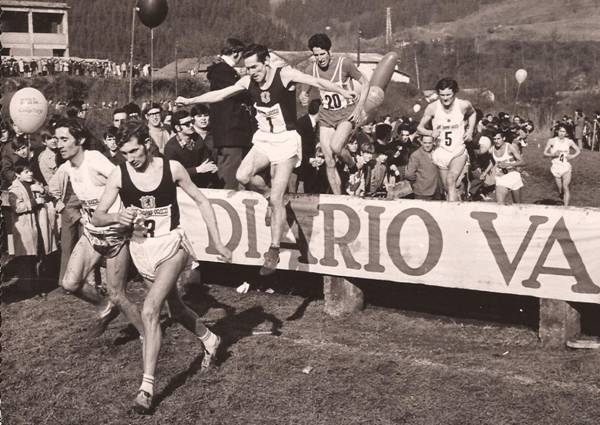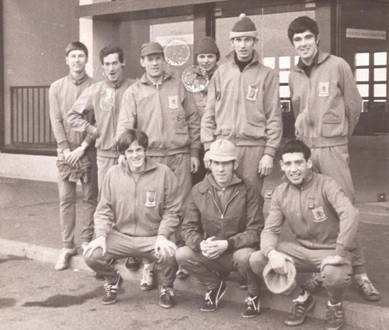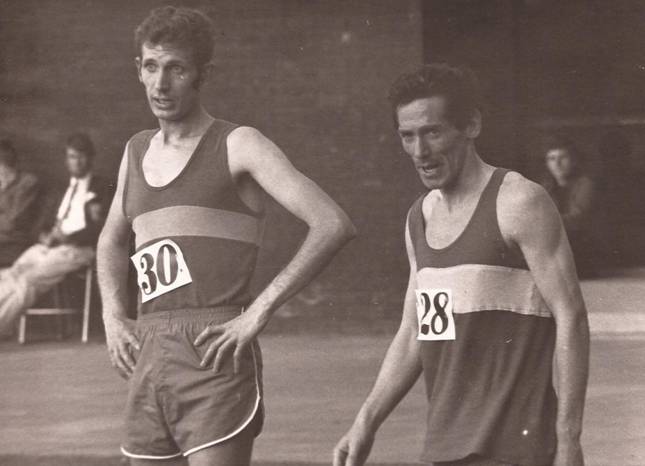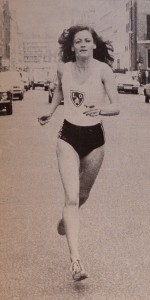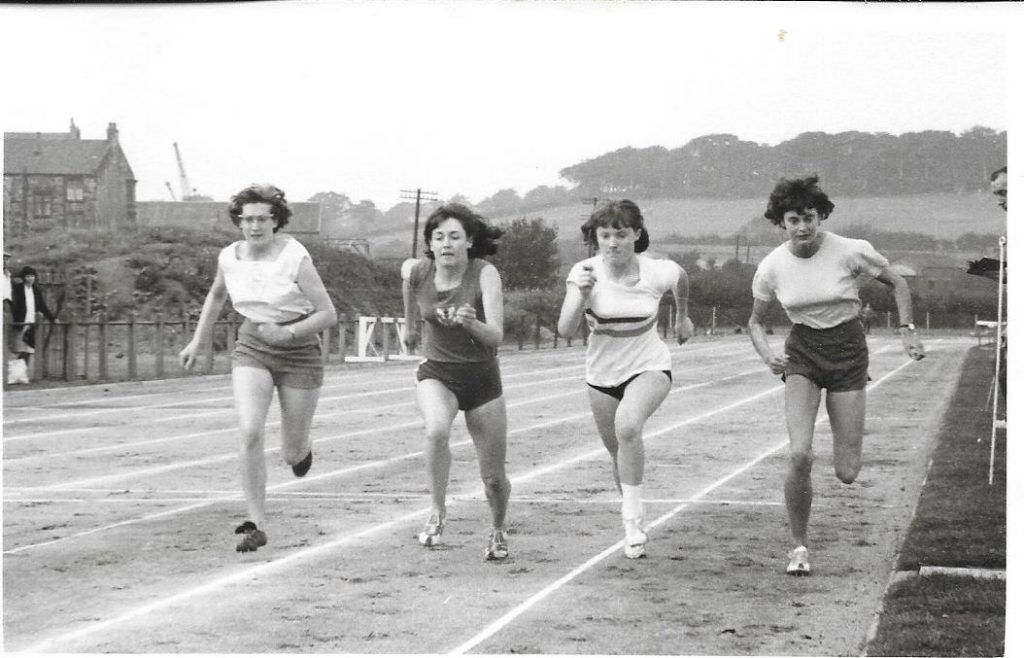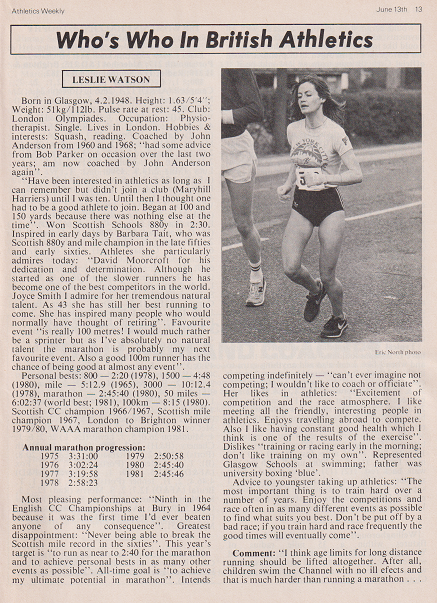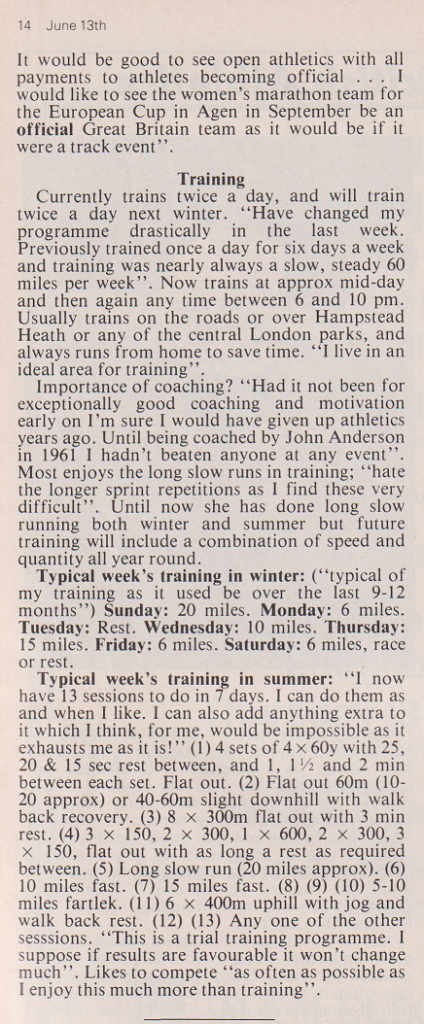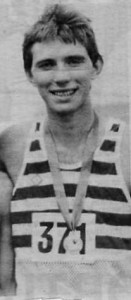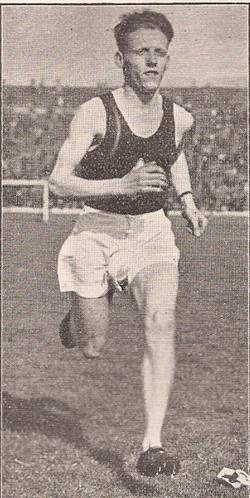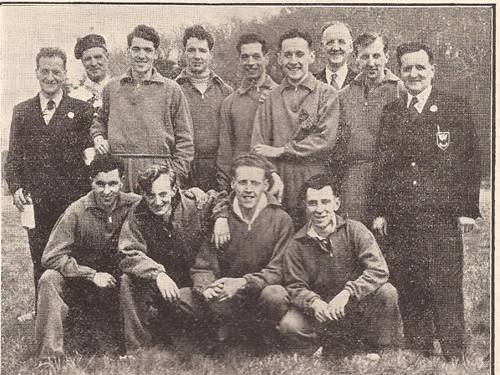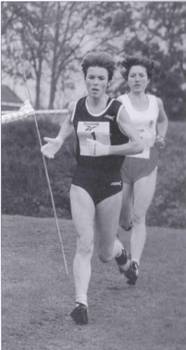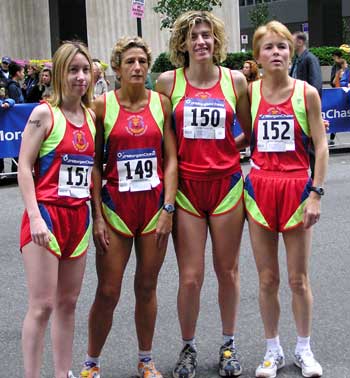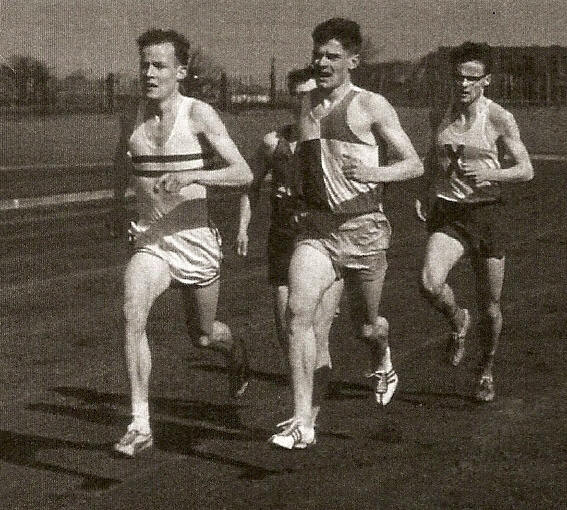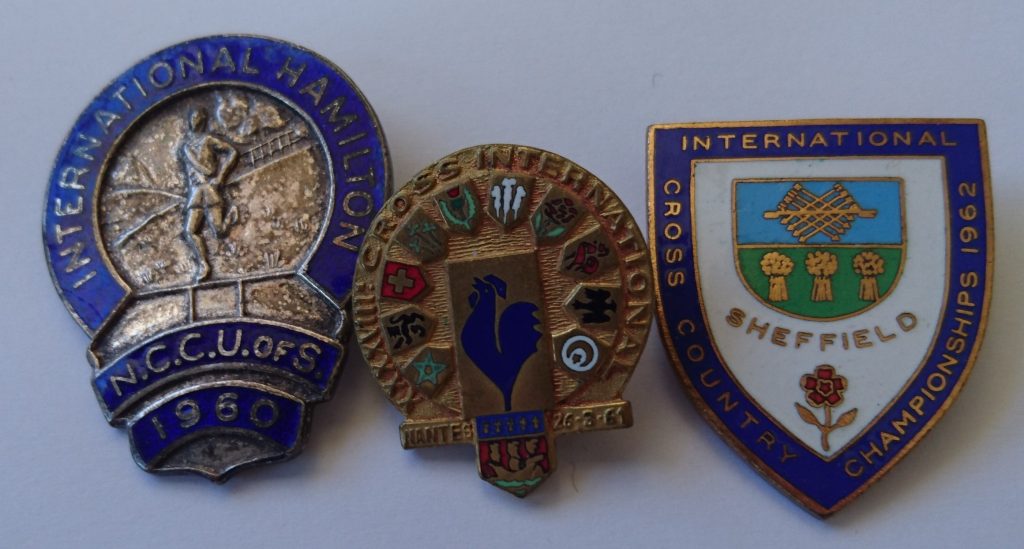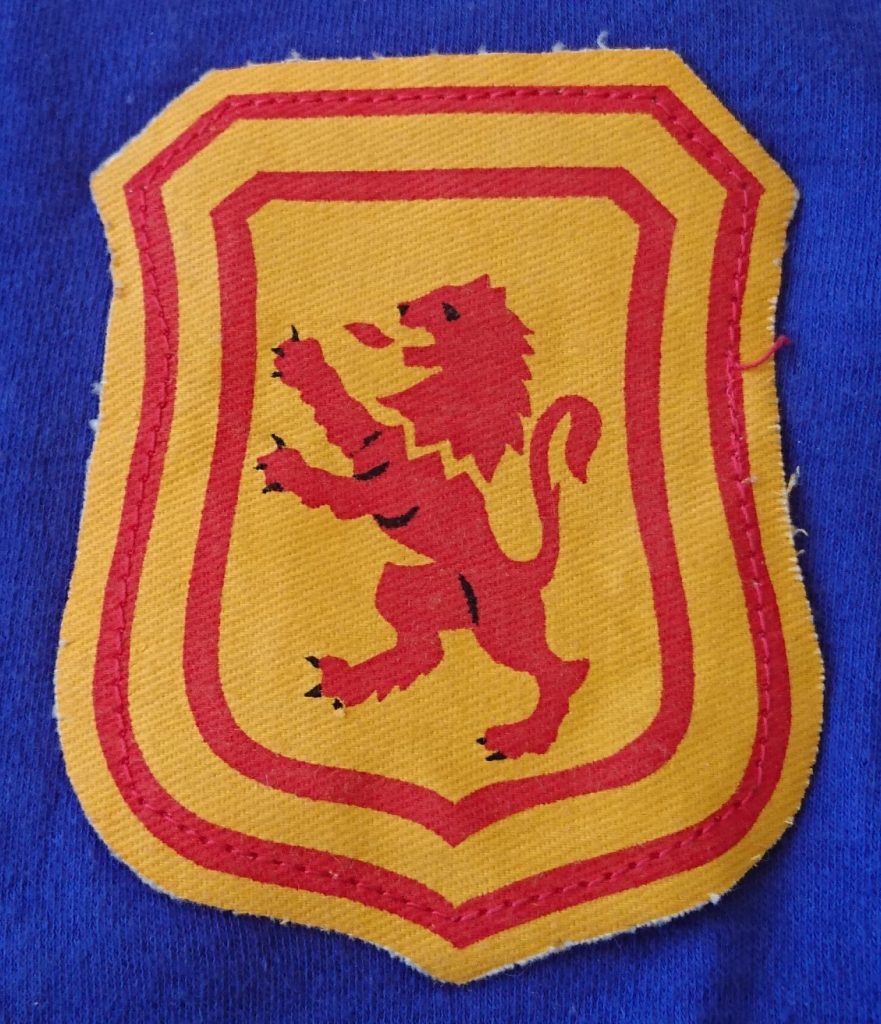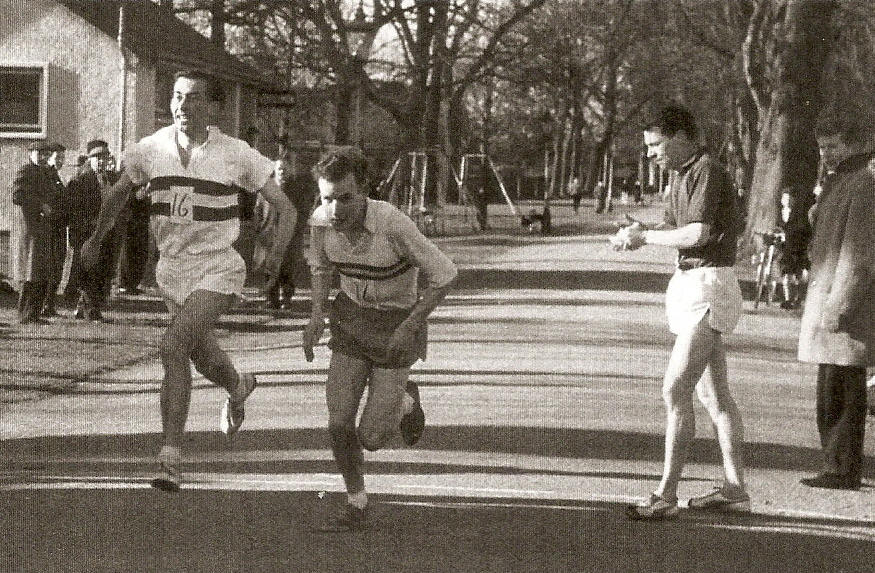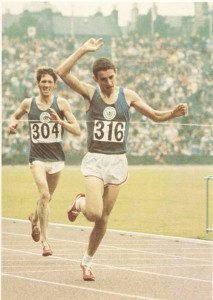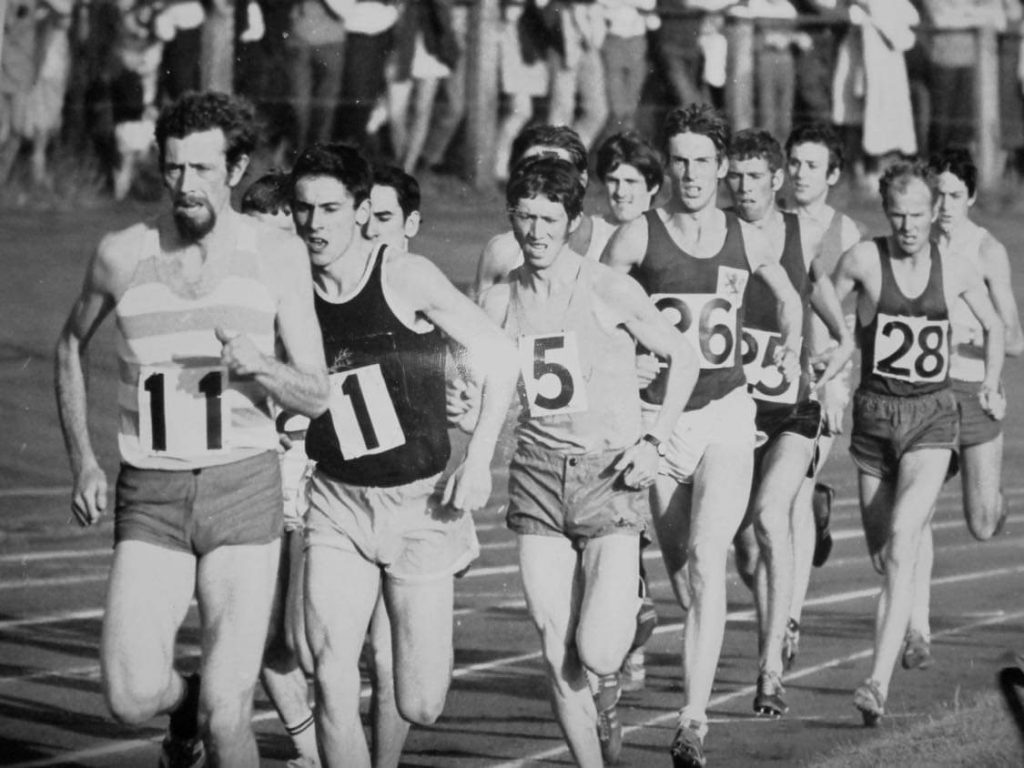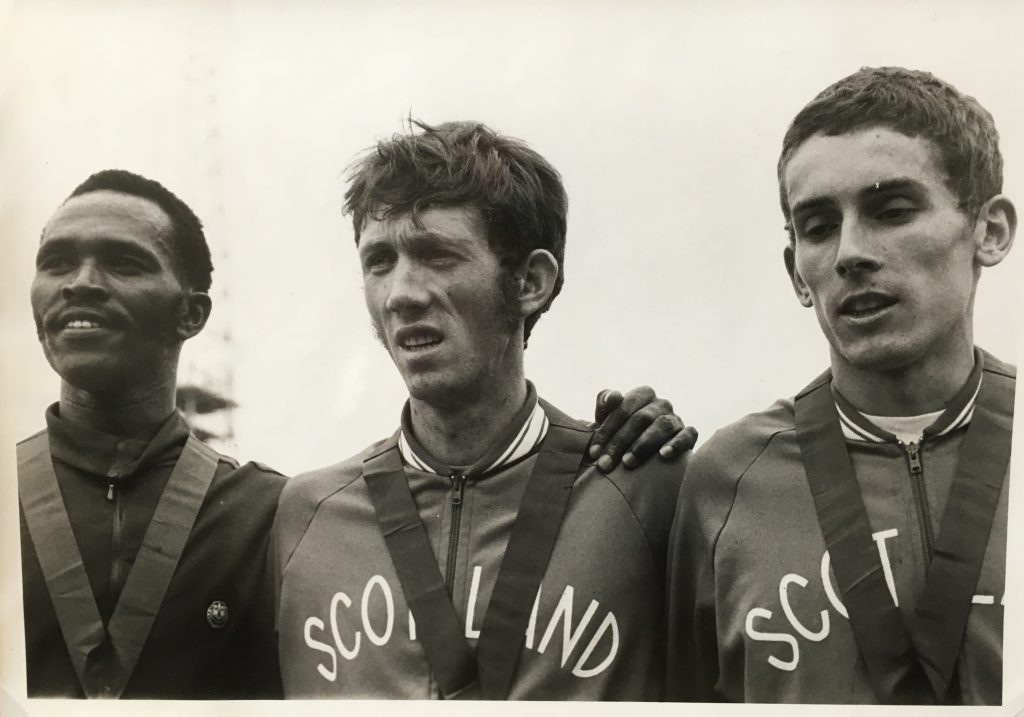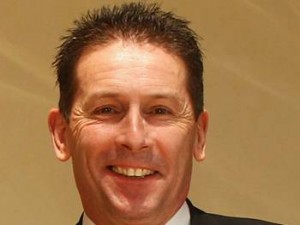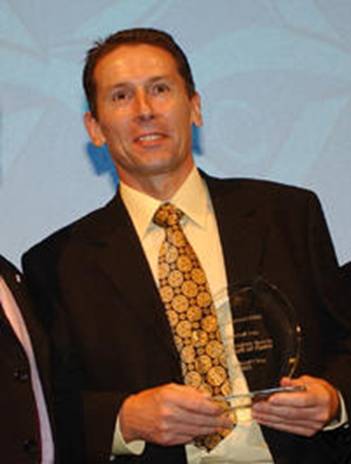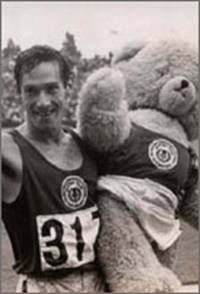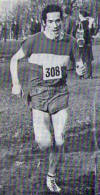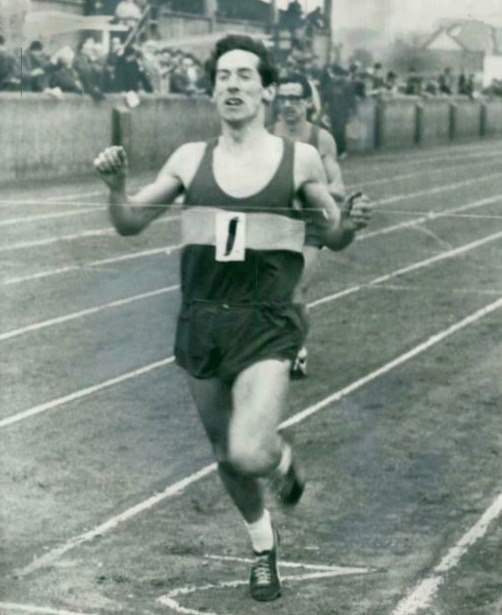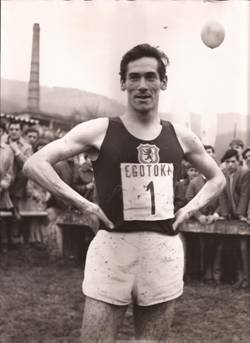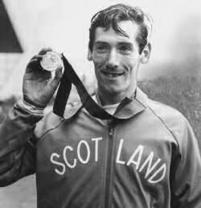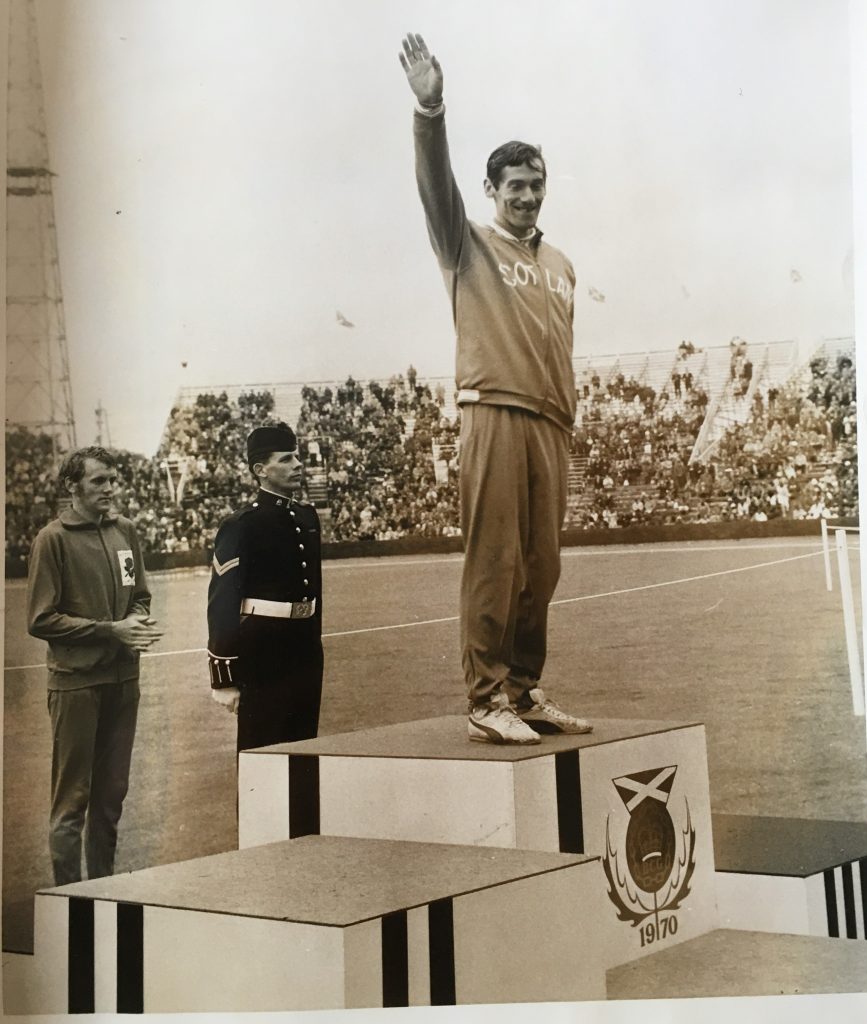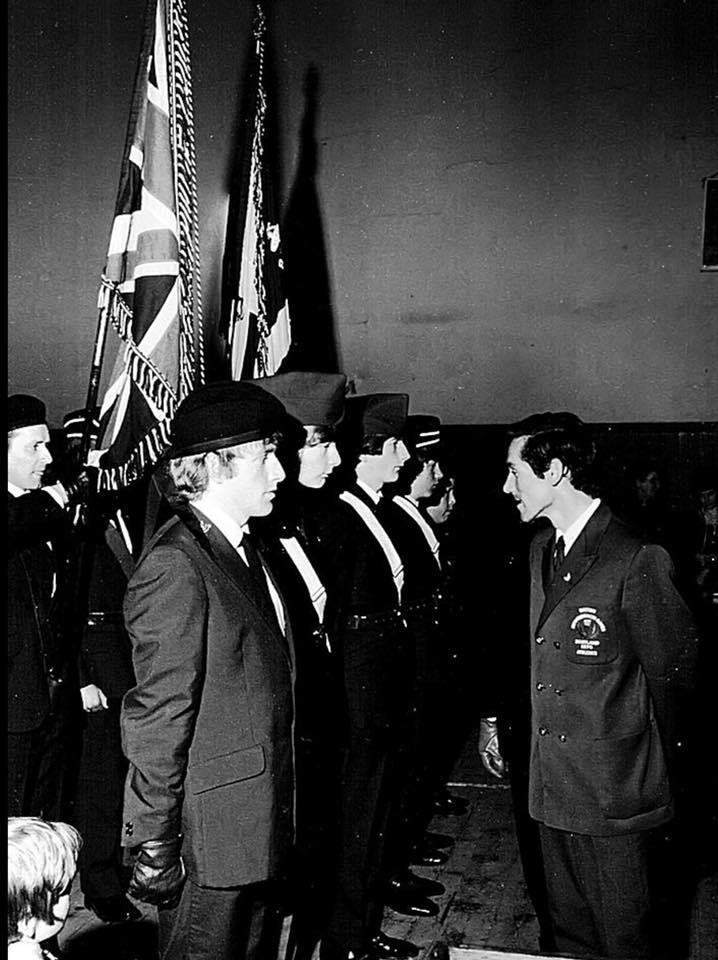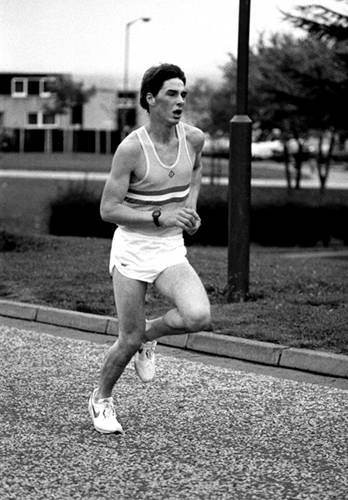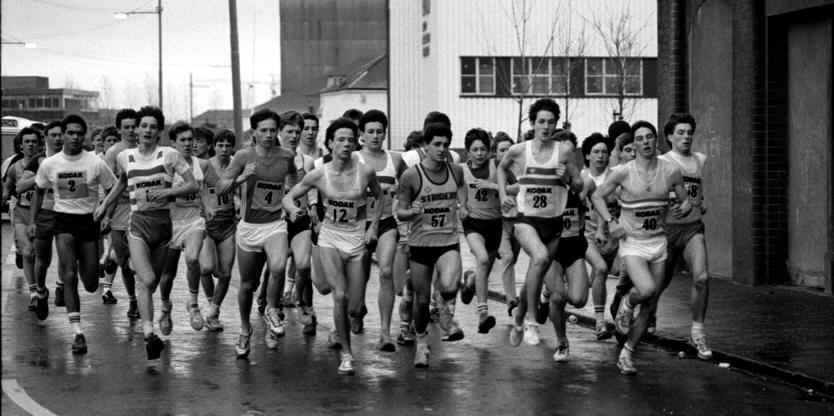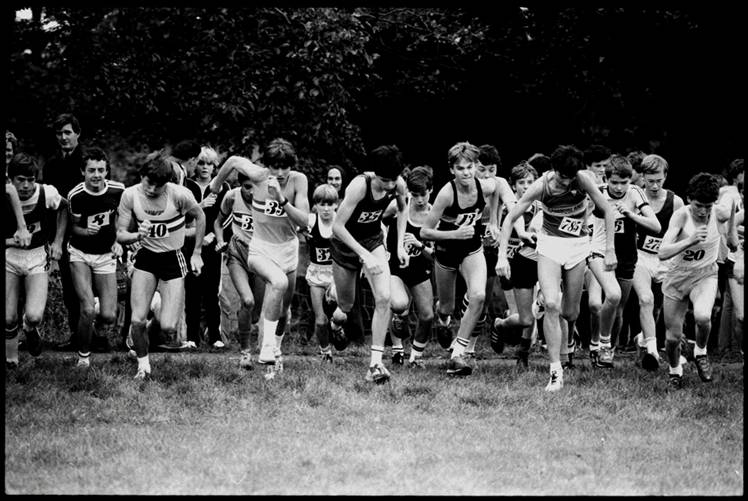Dick Wedlock (3) leading the international field at Elgoibar in 1972 including Lachie Stewart (1)
His record here was a good one: 1970 5th, 1971 8th; 1972 4th (10th M Gammoudi!)
Dick Wedlock was a superbly good athlete who was maybe unfortunate to be competing at the same time as Lachie Stewart, Ian McCafferty, Ian Stewart, Fergus Murray and Don Macgregor. A Commonwealth Games competitor in 1970, his run was overshadowed by Lachie’s superb victory, a multi-international in the world cross-country championships and a very good road runner, he always found the spotlight on others. In the twenty first century he would be an undoubted star of Scottish and British endurance running. His unfortunate accident brought him headlines of the wrong kind altogether and to some extent ensured that he would be remembered for something other than his athletic qualities. How good was he? Let’s just list some of his achievements:
- 5 senior appearances in the World Cross-Country Championships and 1 Junior
- Dick won the Scottish cross-country championship as a senior in 1969, was second in 1970 and third in 1971, plus bronze medals in the Junior and Youth Nationals
- 5 gold and 3 silver team medals in the Edinburgh to Glasgow from 9 runs plus a gold, two silver and one bronze in the Senior National,
- Team gold in the English CC championships.
- Team silver in the European Clubs CC Championship twice
- Commonwealth Games 10,000 metres, 1970
- Best times of 8:17.8 (3000m, 1970), 8:59.4 (Two Miles, 68), 13:47.0 (Three Miles, 68), 14:21.6 (5000m, 70), 29:57.4 (Six Miles, 66) and 28:42.6 (10,000m, 70) as well as being an able steeplechaser.
- Three silver and two bronze medals at SAAA Track Championships.
Well-liked and highly respected he has been overlooked for too long.
Dick Wedlock (Born on 26th January 1946) started off as a Junior Boy in Shettleston Harriers. The Shettleston Harriers Centenary History tells the story of his beginnings: “Allan Scally first spotted Dick as a 12 year old at the St Bridget’s Secondary School Sports at Maxwell Park, Baillieston, in 1958. Within months Allan was predicting a great future for his new protege: ‘I have complete faith in this new boy. His performances to date are comparable to any of the well-known athletes I have coached, even Eddie Bannon and Graham Everett.’ Perhaps the fact that coach and athlete shared the same birthday served to enhance the relationship. For the next four years Dick was a regular member of the boys teams and by the age of 16 was Midland District Champion, Lanarkshire champion, Lanarkshire Mile and Scottish Half Mile record holder, culminating in the National Senior Boys title in 1961. When he defended his title the following year he was beaten by Duncan Middleton, Springburn Harriers, his first defeat in two years, a result he reversed a few weeks later”
Dick was clearly very good right from the start and had dominated the Shettleston club championships winning the Senior Boys titles in 1960, 1961 and 1962 and the Youths title in 1963. Not surprisingly it came as a shock when he decided to leave later in 1963. Shortly after the defeat by Duncan, he joined Motherwell YMCA in a move that took many by surprise, Barred from team competition for 14 months, he ran as an individual and won many races and titles before helping helping Motherwell win District and Edinburgh to Glasgow titles. When he left, champion decathlete and staunch Shettleston man Norrie Foster is quoted as saying, “The first thing we must remember is that we are amateurs and if Dick feels that he can better his running by leaving, then he has every right to do so. Instead of grumbling, let’s find out why he is leaving, and if the fault lies with us, put it right.” This magnanimous attitude is possibly one of the reasons that Dick returned to Shettleston when the Motherwell YMCA club split on the formation of Law and District AAC.
He started his career with Motherwell in 1964 in the style that he left Shettleston: third in the Inter-Counties behind Springburn’s Knox and Middleton, first by 15 seconds in the Scottish YMCA Championships, third in the National, again behind Knox and Middleton all achieved in February before winning the British YMCA Championships (held at Paisley) by 200 yards. Into the summer and in the Lanarkshire Championships he won the Junior 880 yards in 2:02.3, and finished second in the mile. He was not placed in the West District Championships the following week and was also unplaced in the SAAA Championships – no disgrace with opposition like Graeme Grant (Dumbarton), Knox and Middleton in the same age group – but came the winter and he ran in his first Edinburgh to Glasgow in November 1964. Motherwell and had no fewer than five best stage time – Alex Brown was first on the first stage, Andy on the fourth stage, David Simpson on the fifth, Ian McCafferty on the sixth, Dick on the seventh (32 seconds faster than the second quickest) and John Poulton on the final stage brought the team home. Bert McKay and Willie Marshall made up the team. It was an excellent debut. At the start of the season in October he was in the second team for the McAndrew Relay, the Lanarkshire Relay (sixth fastest Motherwell man) and the Midlands District Relay at Cleland where Motherwell teams were first and third (he was fifth fastest Motherwell man) before the ‘big one’ – the E-G in which he performed so well. Motherwell was so strong at this time that they were winning in virtually every race and although he probably raced in the Lanarkshire Championships, the Nigel Barge, etc his name does not appear again until the Midland District in mid-January where he finished sixth to be first Junior. In the Inter-Counties in February he finished third behind Lachie Stewart and A Carse of Edinburgh and fourth in the Scottish YMCA Championships. On to the National Championships in February where he was a first year Junior who had been third in the Youths race the year before. This time he was fourth in the Junior race behind McCafferty, Roger Young of Edinburgh University and Alex Brown. This gained him selection for the Scottish team and in the International he finished twenty fifth to be a scoring runner for the team.
His only ranking the following summer was for the steeplechase where he recorded 9:49.4 to be fourteenth in Scotland but Dick’s name did not appear in any championship or open meeting but he was no doubt a member of several Two and Three Mile teams held throughout the summer because he came into winter 1965/66 in good shape. We don’t know how well he did in the McAndrew since he wasn’t in the first team of McCafferty, McKay, Brown and Brown, but the following week when Motherwell mixed their first two teams to take first and second in the Lanarkshire Relays, he was in the first team of AP Brown, I McCafferty, R Wedlock and M McNulty who won with Dick’s 12:39 being the sixth fastest of this outstanding club squad. Seven days afterwards he was lead off man for the second team in the YMCA relays and led the first team at the changeover – despite this he was still only sixth fastest club man in the event. He was therefore not in the first team which won the District Relays at the end of October, and he may also have run in the Glasgow University Road Race but the big one was the Edinburgh to Glasgow in the middle of November. This time the Motherwell club had to be satisfied with second place to Edinburgh University described as the best University cross-country team ever assembled – with the students faster on six of the eight stages. Dick ran the third fastest time on the final stage and took over over a minute behind Roger Young for the University: he had third fastest time behind Alastair Johnston (VPAAC) and Young who was ten seconds quicker than he was. Thereafter it was back to the second team for this talented runner who had, probably without realising it, run his last E-G for Motherwell. Motherwell won the Nigel Barge Road race at the start of 1966 (with the two Browns and Bert McKay the top team and the second team was sixth) and also the District championship where Dick was probably among the counting runners but not among those named in the Press. It was into the National Cross-Country at Hamilton where Dick did not figure in the results at all. In summer 1966 he won his first SAAA Senior track medal. It was in the Six Miles where he was third in a time of 29:57.6. But, maybe more important, 1966 was the year when Dick left Motherwell and moved back to Shettleston. He was now just coming up to twenty one and had had a very good career so far. He had raced with and watched and learned from some of the very best athletes in the country at both Motherwell and earlier with Shettleston. It was natural that his very best years were yet to come and would be spent in the blue and gold of that club. The Shettleston Harriers history remarks “When some Motherwell members left to form Law and District AC, Dick returned to Barrachnie to play a key role as the club emerged from its fallow time.”
I am going to jump to the winter of 1967 which was when he was available for team duty and things really started to hum – for Dick and also for Shettleston. The October relay season saw the Shettleston team unbeaten abd unbeatable – he had come from the totally dominant Motherwell YMCA to the equally powerful Shettleston just at the point of transition. The results of October are summarised in the table below.
| Event | Position | Team and Times | Remarks |
| McAndrew Relay | 1st | W Scally 13:49, R Wedlock 14:02, M McMahon 14:25, A Blamire 14:07 | RW second fastest club man |
| Lanarkshire Relay | 1st | Blamire 10:37, Scally 10:47, L Meneely 11:04, Wedlock 10:49 | RW third fastest club man |
| Dundee Kingsway | 1st | Meneely 14:10, Scally 13:40, Wedlock 13:45, McMahon 14:15 | “Shettleston Victory After Fine Runs By Scally and Wedlock |
| Midland District | 1st | McMahon 14:54, Wedlock 14:01, Scally 14:15, Meneely 14:54 | RW fastest club man |
It was clear that this team would do well and in the Edinburgh to Glasgow in November the club, seventh in 1966, improved to second with a very good squad forward: Norman Morrison third on the first stage, A Blamire held third, Martin McMahon was still third at the end of the third stage, Bill Scally pulled the team up to second, Les Meneely on five dropped back to third, Dick ran the long and very competitive sixth stage and pulled the team back up to second with the third fastest run of the day, Bill Mullett and Henry Summerhill brought the club home in second. This was the famous race where there was a dead-heat awarded for second place. Henry Summerhill for Shettleston and Terry Baker of Aberdeen were neck-and-neck heading for the line when a taxi cut across in front of the Aberdeen man; Summerhill took the chance and accelerated away to cross the line first. The judges held a street corner conclave and announced a dead-heat. Not only Dick’s first year back but he had already won three gold medals in the short relays and here was a silver one in the Edinburgh to Glasgow. At the time of the Kingsway Relay, Ron Marshall of the ‘Glasgow Herald’ spoke to Dick who “attributed his big improvement this season to avoiding injuries and having a fast group of men to train with. It has also been no disadvantage for him to set up home a mere sprint away from Shettleston’s track!
On 25th November Dick won the match between the SCCU and the Army and was selected for the match against the Universities on 9th December. On 2nd December in the Lanarkshire Championships, he was fifth – behind McCafferty, Knox, Brown and Brown! Three of his former Motherwell team-mates in the first four. In the match against the Universities he was fifth but moved up to fourth because in fourth place was a non-scoring reserve – the very good Jim Brennan of Maryhill. At the start of 1968 he took part in the Nigel Barge Road Race at Maryhill and finished fifth in the same time as team mate Norman Morrison in the Shettleston team that finished third. The following week, Dick won the Springburn Cup road race from Jim Brennan and the ‘Herald’s’ reporter suggested that the carrot of a trip to a European cross-country race had encouraged the vegetarian Wedlock. He was listed as a reserve for these events which were frequent at the time. There were several cross-country races held on the Continent every winter and the Scots three- and four-man teams were popular and successful with Lachie, Ian, Fergus Murray, Jim Brown and company all doing well and advertising the quality of Scottish endurance running. One of these was in Elgoibar and on January 20th Dick finished fourteenth there in a team where Lachie Stewart was second. In the National at the end of February, won by Lachie Stewart of Vale of Leven AAC, Dick was the first Shettleston Harrier to finish when he crossed the line in eighth place. Shettleston were fifth placed team. No place was found for him in the team when it was selected the following Monday evening.
In summer 1968, Dick was ranked in the One, Two and Three miles with best times of 4:11.6, 8:59.4 and 13:47. In the Scottish Championships at Grangemouth on 22nd June he was second to Lachie Stewart in the Three Miles in 13:50.4 to Lachie’s 13:48.4 with Alastair Blamire third in 13:52.6. Although running for Vale of Leven, Shettleston and Edinburgh University, they would soon all be running as part of a superb Shettleston Harriers team. In general though, he kept a low profile over the summer season.
Winter 1968/69 started with the McAndrew Relays at Scotstoun, and the headline in the “Glasgow Herald” read ‘Easy Victory For Shettleston In McAndrew Relay’, and the text read “Shettleston Harriers gave notice on Saturday of what should be a succession of relay wins in the coming months when they led the field in the McAndrew Relay at Jordanhill from start to finish. Their winning time, 55:20, was less than a minute outside Motherwell’s record set three years ago. The move to Shettleston from Vale of Leven of Lachie Stewart certainly bolsters the formers strength but as it turned out on Saturday, they could have won just as easily using their fastest man in the B team, Alastair Blamire. He had been unable to run in the club’s trial the previous Saturday and so went automatically into their B quartet. Blamire chased his clubmate Dick Wedlock spiritedly round the three mile circuit and finished only 16 seconds behind, well clear of any chasing runners. For a long time afterwards, the B team looked capable of finishing second overall, but Summerhill who dropped one place and, more particularly Patterson on the third leg let the chance slip. Stewart and Wedlock shared the fastest individual time of 13 minutes 30 seconds and fourteen seconds slower came Ian McCafferty” Team and times: R Wedlock 13:30; M McMahon 14:09; JL Stewart 13:30; W Scally 14:11. Seven days later it was the Lanarkshire Relays where the Seniors won again, thanks to a good team performance- Bill Scally’s first stage where he kept Alex Brown at bay, Lachie Stewart’s second stage where he increased the lead against Ian McCafferty and Dick Wedlock and Martin McMahon on the last leg. . The four fastest times were Stewart, Wedlock, McCafferty and Scally. In the Midland District Relay Championship two weeks later they won again, this time the heroes were Tom Patterson 11:53, Dick Wedlock 11:47, Bill Scally 12:03 and Lachie Stewart 11:44. It was a surprisingly good run by Tom who had been in the second team for all the other relays.
The short relay season over, all the ‘big’ teams – Shettleston, Law and Bellahouston – kept all their men out of the GU Road Race. Came the Edinburgh to Glasgow eight-man relay the following week. Martin McMahon was fourth at the end of the first stage and Norman Morrison dropped to fifth on the second stage, Tom Patterson on the third stage moved them from third to second and Dick Wedlock put them in front – from then on it was no contest and they were only two seconds (a quarter of a second per man, as Ron Marshall said in the ‘Herald’) outside Edinburgh University’s record. On the very last day of the month, Dick ran in the SCCU v The Army and was third behind Blamire and McCafferty. In the Lanarkshire championships on the first Saturday in December, he was second behind Lachie Stewart in the winning team. Dick received a nice early Christmas present when he was chosen in December as part of a three man team – Lachie Stewart and Jim Alder were the others – to race in Hannut, Belgium, at the start of February. In the Nigel Barge at the start of January 1969 he finished second, behind Lachie but in front of Andy Brown and Bert McKay. The following week, in Lachie’s absence Dick won the Springburn Cup by almost a minute from Harry Gorman of the host club. Then came the race in Hannut on 1st February: won by Gaston Roelants from Tim Johnston, the Scots runners were down the field a bit. Lachie who had won the race the previous year, was clearly out of sorts and finished twenty fifth, Jim Alder was fifteenth and new boy Wedlock (referred to in the report as ‘Ron’) was eighth and first Scot. Selection repaid! On 8th February, Dick won the Shettleston Harriers club championship and the Nationals were not far away. It was Dick’s chance to shine and he had a brilliant run to beat them all – McCafferty, Lachie (recovering from ‘flu to be fair), Myatt, Alder and all the rest. Selection certain. for the international which, this year, was a ‘homer’ for the Scots being held over a hilly course at Mountblow Golf Course in Clydebank.
The events are covered on page 138 of Colin Shields’ official history of the cross-country union as follows: Lachie Stewart defeated Mariano Haro (Spain) in the Elgoibar International race before being struck down by ‘flu. He had barely recovered by the time of the National Championships at Duddingston Park in Edinburgh where the ground was icy, rutted and rock hard after a bad spell of weather. Still suffering from the after effects of the ‘flu, Stewart had no chance of achieving his third successive win and finished a disappointing tenth. Dick Wedlock shared the lead with Alder for three of the five laps before striking out on his own over the final three miles to score a deserved victory. His only other National win had been in the Boys race eight years earlier and in the intervening years he had the misfortune to record good performances, which would have won races in any other era, behind such illustrious names as McCafferty, Murray and Stewart. Alder faded in the last couple of miles and Fergus Murray sped through to take second place, 8 seconds behind the winner. ….. The international championships, for the first time since 1960, were staged in Scotland and the Union, in conjunction with Clydebank Town Council, staged them at Clydebank. A hilly picturesque course was laid out around Dalmuir Park and the adjacent golf course, that was acclaimed as the most testing course over which the championship had been held for a number of years. Without any of the bad luck that had affected his performance in previous international championships, Ian McCafferty fiished third for the best individual performance by a Scot since Flockhart’s victory in 1937 in Brussels.” Dick finished 36th to be one of the scoring men in a good Scots team.
Scottish team at Vichy: Weatherhead, Stewart, Stoddart, Falconer, Wedlock, Bryan Jones, in front: Morrison, McCafferty and Alder.
With the Commonwealth Games being held in Edinburgh in 1979, 1969 was a key year for all Scots track runners. Dick started his season on 17th May with a win in the Land o’ Burns Trophy meeting Three Miles in 14:9.4 – three and a half seconds clear of Eddie Knox in second, but he didn’t appear in the first three in any of the middle distance events at the West District Championships at the end of the month.. He next appeared in the columns of the Press after his second place in the SAAA Championships at the end of June. Held at Grangemouth, the 5000m race was won by Lachie Stewart 14:09.6 with Dick second in 14:24.8 and Bert McKay third in 14:30.8. By the end of the season, Dick was ranked 14th in the 3000m with 8:27.8, third in the 5000m with 14:03.4 and twelfth in the 3000m steeplechase with 9:34.8. The 5000m time was actually third equal with Michael Bradley who was better known as a miler/1500m runner, and they were both behind Lachie Stewart (first with 13:55) and Gareth Bryan-Jones (second with 13:56) and ahead of Jim Alder (14:03.6), Fergus Murray (14:06), Alastair Blamire (14:07) and Ian McCafferty (14:13.6). With scalps like these under his belt, the selectors had to take even more notice of Dick Wedlock in Commonwealth Games year.
The winter of 1969/70 started as normal with the McAndrew Relay race organised at Scotstoun by Victoria Park AAC. Except that for Shettleston, Dick Wedlock did not run – he was substituted by Junior Man, Joe Brolly and the best they could do was second. He was however forward for the Lanarkshire championships where he ran the third stage and came from 170 yards down on Law & District to hand over a winning lead to young Joe Brolly. He ran the first stage of the Kingsway Relays at Dundee the following week, led the field home and shared the fastest time of the day (13:25) with Fergus Murray. The team could only finish third this time. The West District Championships were held on 1st November and the Shettleston team were given a big lead by Dick Wedlock on the first stage over Andrew Brown of Law and District – this time he was fourth fastest over the course. Shettleston’s top men all avoided the Glasgow University race and then in the Edinburgh to Glasgow Relay, they finished second to Edinburgh Southern Harriers – Dick was one of three club men who set the fastest stage time of the day when he was 19 seconds faster than Bryan-Jones on the fourth stage.
1970 started with a victory for Dick in the Beith race on 1st January and two days later, the Nigel Barge road race where he was again second to Lachie Stewart in a very illustrious field. After the race, the Scottish selectors agreed that the team for Elgoibar and for San Sebastian on the 18th and 25th of the month would be Lachie, Dick and Adrian Weatherhead of Edinburgh. In San Sebastian, the Scots were fourth with Lachie Stewart fourth, Dick was sixth and Weatherhead twentieth, other than Lachie winning, the result of the Elgoibar race is not known. His good running continued with a victory in the Inter-Counties cross-country championship on 31st January when he won by 9 seconds from Ferguson of Ayr having led from start to finish and his second successive victory in the Shettleston club championships in the next two weeks. In the National on 24th February, on Ayr Racecourse, was won by Jim Alder with Dick Wedlock second and Bill Mullett third. The team in the photograph above was chosen with Bill Stoddart and Jim Wight as reserves. In the race itself, the Scots team again were ‘so near and yet so far’ and their excellent team finished fifth with their last three scoring runners in 42nd, 4th and 46th – Dick was 45th. It had however, been a very good winter for the Shettleston man and he went into the summer of 1970 in great shape.
His first appearance that summer was the West District Championships and in the 5000m on a slow Westerlands track, he was third behind Lachie Stewart (14:10) and Mike Bradley (Springburn, 14:20) in 14:30. Bradley was the form man – he had won the 5000m at Meadowbank at the beginning of May and the 1500/5000 double in the Lanarkshire championships. Dick made his big bid in a tremendous race with Lachie Stewart in the Scottish Championship at Meadowbank on 5th June when Lachie won in 28:33.4 and Dick was second in 28:42.0. If you want to see how hard it was, have a look at the photograph below, which I obtained from Lachie. They went into the Games as second and third fastest behind Jerome Drayton of Canada. Most of the English Press didn’t believe it: I remember watching the English 10000m championship and hearing the commentator (I think it was David Coleman) saying that “Lachie Stewart is said to have run 28:33 in Scotland”. Mel Watman in the “Athletics Weekly” of 18th July 1970 had an article on ‘Who To Look Out For In Edinburgh’ in which he said about the 10000m: “I confess I shall be unable to view this race with professional detachment. I badly want Ron Clarke to win. Clarke is the athlete I admire most in the world and I feel that it would be a gross injustice should he pass from the scene without a gold medal to his name. If he can’t make it, and there has been little evidence lately that he is anywhere near his very best form (which may prove beneficial as the “big one” may come at just the right time), then I hope it’s Dick Taylor who succeeds – just to shame the critics who kicked him when he was down last September. Temu (the Olympic champion), O’Brien, Drayton and Matthews among others should make sure it does not develop into a private duel. Mel Watman: 1. Clarke; 2. Taylor; 3. O’Brien. Stan Greenberg: 1. Matthews; 2. Clarke; 3. Drayton.” Two eminent statisticians and not a mention of the men ranked second and third in the Commonwealth and no real reason for their prediction – Clarke because he ‘deserved it’ and Taylor ‘just to show them.’ A reminder of the top ten going into the race: 1. Drayton (Canada) 28:25.8; 2. Stewart 28:33.4; 3. Wedlock 28:42.0; 4. Clarke 28:43.8; 5. O’Brien (Australia) 28:47.2; 6. Caine (England) 28:51.0; 7. Matthews (England) 28:59.8; 8. Taylor (England) 29:05..0; 9. Stephen (Tanzania) 29:15.6; 10. Plain (Wales) 29:26.8.
The story of the race, and Lachie’s triumph is too well known to bear repeating here but in all the hullabaloo about the race, Dick Wedlock acquitted himself nobly in this, his first Games of any sort and at the age of only 24 in an event where athletes mature with experience. He finished thirteenth in 29:09.8. The full results are at the Commonwealth Games website, just click on the link for a or the full list http://www.thecgf.com/games/results.asp Undoubtedly the high point of his career so far, Dick and his supporters were looking forward to even better things to come.
Dick and Lachie after the trial: they knew they’d been in a race!
Not surprisingly with both Stewart and Wedlock plus Norman Morrison in the team, Shettleston won the McAndrew Relay with Bill Scally the fourth man running only one second slower than Dick. The club mixed the runners up a bit and won the Lanarkshire 10 Mile Road Relay with their B team in second place. Dick ran the last leg of the A team and like the previous week, was not the fastest man in the team – even with Lachie Stewart in the B squad. By the Midland District Relays on 7th November he had started to show his true form with joint fastest lap with Shettleston team-mate Norman Morrison. As in the Lanarkshires, Shettleston had first two teams. The Shettleston runners again avoided the Glasow University road race, preferring to prepare for the Edinburgh to Glasgow relay – it was clear that they had an outstanding team. The very good quartet from the previous winter of Stewart, Wedlock Morrison and Scally were still there and arguably in better form than twelve months before and such as Henry Summerhill, Tom Patterson, Les Meneely and Tom Grubb were all looking sharper and were certainly a year more confident. The team on the day in running order was Grubb, Wedlock, Patterson, Morrison, Summerhill, Stewart, Meneely and Scally and they were given a really hard time of it by Edinburgh Southern Harriers – ESH led for the first four laps and there were seconds in it all the way – indeed at the end of the third lap the were neck and neck with a time of 1:20:33 each, after the fourth stage the times were 1:50:32 and 1:50:33. Even after the long sixth stage the gap was only 46 seconds and at the end of the race Shettleston won by 13 Seconds. Dick had had a super run on the second stage, turning in the fastest time ahead of Fergus Murray, Hugh Barrow, Frank Clement, Jim Wight, Colin Youngson and Doug Gunstone. The ‘Glasgow Herald’ for 7th December had the headline, ‘Splendid Victory for Wedlock’ after he had beaten Lachie Stewart by 66 seconds in the Lanarkshire Championships with Tom Patterson third.
On 12th December the SCCU team was beaten into fourth place but Dick Wedlock had a superb run finishing second to Andy Holden after a hard race. The three top men were absent from the SCCU team since they were racing in San Sebastian. The report on the race read: “Wedlock made a change of plan a few days ago as to how he would tackle the race. A couple of weeks ago he had little intention of going all out. As far as he was concerned the Solihull event would be just a workout at the back of the field. He changed his mind however in mid-week and it was just as well for the SCCU as the nest Scot was Norman Morrison in twentieth place. Andy Holden, an international steeplechaser from Preston, was the individual winner, but not before Wedlock had tested him to the utmost over the four-lap trail covering a total distance of 7 miles 600 yards. At half-distance a bunch of about ten runners were setting the standard, when Wedlock, swiftly pursued by Holden, broke away. The short striding Scot with the imperceptible heel-lift created a bit of space for himself but not enough to snap the thread of contact between himself and the man from Preston. Towards the end of the third lap, being run over heavy grassland with few undulations, Holden took over the lead and had about six seconds in hand. He extended this to about ten seconds on the next lap but Wedlock came again on the run-in and was down once more to six seconds. Alan Blinston bronze medallist in the European 5000m last year was eight seconds behind Wedlock”
In the second week of the New Year, He won the Springburn Cup ra e from Alastair Johnston of Victoria Park. but a week later in the Nigel Barge Road Race he was beaten by Ronnie McDonald of Monkland Harriers who was still an 18-year-old schoolboy. They, together with Alastair Johnston, were together until at about 200 yards to go, McDonald just took off. “He was just too fast for me,” said Dick after the race. The National was in February and on 31st January Dick was the highest placed Scot when he was eighth in the San Sebastian International Cross Country Race Don Macgregor was eighteenth and Gareth Bryan-Jones thirty fourth which set him up nicely for the National Championship at Bellahouston Park, Glasgow, where he was third behind Alder and Blamire to lead Shettleston to victory in the team race and earn him selection for the world championships in Spain. Before then however came the English Cross-Country Championships and Shettleston completed their wonderful unbeaten winter season by winning yet again. Blamire (11th), Stewart (19th), Wedlock (24th), Morrison (32nd), Summerhill (64th) and Grubb (131st) were the men. In a very muddy trail for the international championship in Spain, Wedlock was the second Scot behind Ian Stewart (9th) when he was twenty fourth. He had been a counter in every cross-country championship he had run.
The 1971 cross-country team:
Back Row: Bill Scally, Henry Summerhill, Dick Wedlock, Norman Morrison and Alastair Blamire
Front Row: Les Meneely, Tom Patterson, Lachie Stewart and Tom Grubb
In the West District Championships at the end of May 1971, Dick shared the pacemaking with Ian McCafferty before finishing second in 14:45.6 ahead of Hugh Barrow on 14:52.4. It was a good start to the summer if a bit slower than the previous year and a week later in the 500m at Rawyards Park, Airdrie he was second to Jim Brown in an almost identical time of 14:45.8 with Paul Bannon third. There were however no Scottish titles for him this year although he ended the summer with best performances of 8:33.4 for 3000m, 14:27.0 for 5000m and 29:42.6 for 10000m when finishing third in the SAAA Championships, won by Lachie in 29:00.0.
Winter 1971/72 started with the McAndrew Relay. Shettleston won this yet again with Dick Wedlock on the last leg after Scally, Stewart and Summerhill had all done their bit. In the County relay the following week, Paul Bannon of Shettleston was struck by a car on the opening leg; fortunately he was unhurt but the team could only pull up to third by the end of the race with Wedlock on the final stage after Stewart and Meneely. In the Allan Scally Relay at Shettleston Dick had the unusual experience of dropping two places – to Pat Maclagan (VPAAC) and Alastair Wood (AAAC) and could only say at the end that it was just one of those days and he just couldn’t get going. The team won however. The following week, he was back in form and running on the third stage he was the fastest of the Shettleston contingent and second quickest on the day ahead of Lachie Stewart and ten seconds behind Jim Brown. The big one – the Edinburgh to Glasgow was the next race on the fixture list. Shettleston triumphed but not without a serious fight. However it was down to Dick Wedlock to get the team clear when he set off only one second behind Alastair Johnston on the long sixth stage. He was content to run on Alastair’s shoulder right up until the last mile when he moved away to hand over a 70 yard lead and they were never caught thereafter. Only a week later there was a televised cross-country race from Parliament Hill in London and Dick in 15th place was third Scot home, behind Lachie Stewart and Jim Alder. Seven days after that, it was the Lanarkshire Cross-Country Championship which Dick had won the previous year. This time he led until after the halfway mark before the ‘find of the season’, the prodigious Junior, Jim Brown and Ian McCafferty broke away with Brown the winner. At the start of the New Year, 1972, Dick won the Beith race from clubmate Henry Summerhill but the main article in the ‘Glasgow Herald’ was about the European Clubs championship which Shettleston had won the right to contest having won the British championships. It was to be on the 16th of January in Belgium. On January 8th, not running in the Nigel Barge this time, Dick won the Springburn Cup race at Auchinairn by getting clear of club mate Norman Morrison a mere half mile from the finish.
Clearly in fine form Dick went with the rest of the Shettleston team to Arlon in Belgium, representing Britain in the European clubs championship. He performed nobly finishing second to Karel Lismont, European marathon champion. Shettleston, who were ‘set a marvellous example by Wedlock’ finished second with 41 points to the Belgian 17. Dick missed the National because of ‘flu but he was nevertheless chosen for the international championships in Cambridge. With an in-form McCafferty, Lachie Stewart, Jim Alder, Alastair Blamire, Ian Stewart and other first class athletes all chosen, the disappointing results of the previous years were expected to be over. Great things were expected of the team. Meanwhile back with the Shettleston team, if they were to qualify for the European championships they had first to win the English national. Unfortunately 1972 was the year of the notorious Sutton Coldfield race. A severe snowstorm started up as the race began and got steadily worse as the event went on. Many athletes dropped out distressed, some developed frost bite and generally the race was a disaster – Shettleston finished down in 23rd place with1263 points.. Dick Wedlock however ran on and was their first finisher when he crossed the line fifteenth. The Scottish team finished fourth the following week – not bad but everyone, athletes, officials, Scottish runners, the team themselves – all thought that this could be Scotland’s year. Scotland’s long-suffering team manager Jim Morton was not just disappointed, he was angry and gave the team a real tongue lashing in the public prints. He did however, exclude from his tongue lashing Dick Wedlock, who finished seventy second, as ‘this is the first time he’s let me down.’
In summer 1972, Dick appeared in two ranking lists: in the 5000m he was twentieth with 14:31.4 and in the 10000, he was seventh with 29:59.2. He opened the season with a win in the West District Championships at a rainy Carluke in 14:31.4, exactly one second ahead of Alastair Johnston of Victoria Park.
Norman, Dick, Paul Bannon and Lachie won the McAndrew Relay in 1972 and set a course record but Shettleston lost their District Relay title in early November but with Lachie, Dick, Paul Bannon and Alastair Blamire were all absent, being rested by the club for the following week end’s race at Parliament Hill in London. Shettleston did in fact win the team race and Dick was forty third. The Edinburgh to Glasgow Relay of 1972 is remembered as ‘Ian Stewart’s Second Stage’ when the Anglo, running in the colours of Aberdeen AAC, smashed the record of that stage. Dick took over from Alastair Blamire in second place on the fifth stage and Ron Marshall’s report in the ‘Glasgow Herald’ read as follows: “Dick Wedlock chose the right day to turn it on. Chasing after Aberdeen’s Steve Taylor on the five and a half miles to that oasis called the Forestfield Hotel, Wedlock smashed the course record of 26 min 19 sec by 21 seconds and , more important, sent lachie Stewart away with a lead of 48 seconds. The race was over.” Dick started 1973 with fourth place in the Nigel Barge Road Race behind Norman Morrison, Paul Bannon and Doug Gunstone but this time passed on the Springburn Cup race at Bishopbriggs and was also an absentee at the Midland District Championship. It was in January 1973 that Ian McCafferty started talking openly about turning professional and of taking payments – sometimes as much as £100 – and by the end of the month he had burned his boats as an amateur by telling ‘Scotsport’ on STV that he had an offer from USA to join their pro group but he was taking his time about taking up the offer because he had other propositions put to him, such as working with sports goods firms, particularly Puma with whom he already had an ‘arrangement’. The international team would no longer have McCafferty on board. The team was selected after the National in February and Dick was again one of the runners having finished ninth in the championship. The international itself was run in Waregem, Belgium, and in deep mud in some places, shallow mud in others and not very much in the way of firm ground. It was the year that Jim Brown won the Junior Championship to give him the complete set of gold, silver and bronze medals for the event. Dick was well down the field in 120th position. Shettleston, as Scottish champions this time, again took part in the European Clubs Championship in season 1972/73, and again finished second – Norman Morrison won the race, Lachie Stewart was third, Alastair Blamire ninth but Dick, who had been second the year before, dropped this time to eighteenth which gave a total good enough to defeat English team Tipton but not enough to depose the home team.
Summer 73 and the opener for Dick so often in the past, the Lanarkshire Championships at the start of May, had not one single Shettleston Harrier among the competitors. Ron Marshall in his column directing a word of criticism a those on the lookout for non-Scottish competition. They are, he said, becoming so selective that dozens of Scottish competitions are becoming denuded of their presence and so devalued. BY the District Championships at the start of May he still had not shown his hand – the District Championships were contested mainly by Lachie (the winner), Alastair Blamire and Lawrie Spence. Nothing at all that summer on the track – and it was the summer before the Commonwealth Games in New Zealand in January 1974. The official Shettleston Harriers history said that a long term injury had ruled Dick out of contention. Summer 1973 was basically written off.
Into season 1963/74 and the ‘Herald’ report said that Shettleston fielded none of their top four runners and paid the penalty. They were actually ninth in the race and then eleventh in the Lanarkshires. There was some consolation when they finished second to Victoria Park in the District Relays. Although the team did not do as well as the year before, they finished sixth, Dick was on the fifth stage where he pulled the team up two places from ninth to seventh with the second fastest time of the day behind Martin Craven. He was not in either the Nigel Barge or the Springburn Cup or the District Cross-Country races in January. In February, he did run in the National and finished forty first and was nowhere near selection for the international. Summer 1974 was like summer 1973 with no medals or rankings.
When Ron Marshall came to report on the McAndrew Relay in October 1974, he wrote towards the foot of his piece, “one competitor conspicuously missing from the fray was Dick Wedlock who is ill in hospital after a road accident on Thursday. So often in these four man relays, Dick was considered as one of the mainstays of the Shettleston team. His absence on Saturday cast a cloud not only over his club colleagues, but over all of us who have watched his many fine performances these last six or seven years.” The report sounded a bit like an obituary – and Dick’s running career was certainly over. The story is told in the Shettleston Harriers centenary history. “The main talking point at the McAndrew Relay on October 5th, 1974, had nothing to do with athletics – at least not directly. Three days previously Dick had been taking part in a Fire Service sponsored run from London to Edinburgh. As the group approached Newcastle, he was resting with other runners in the back-up minibus parked in a lay by. In 2003 he recalled the seconds that changed his life forever. ‘I was stretching out on one of those long seats with my foot against the door and my head resting against the back of the driver’s seat. I had just been handed a cup of tea when through the rear window I saw a lorry heading straight for us at speed. I was the only one to see it and though I shouted out a warning, it was too late.’ The force of the collision drove the rear of the bus towards the driver’s seat. Of the three other fire-fighters on board, one was thrown clear, another wrenched his back and a third, Sinclair Watson of Maryhill Harriers, was badly cut by flying glass. Dick sustained a broken foot and a broken neck, was paralysed from the neck down and in spite of early hopes would never walk again.”
Dick was just 28 years old and at an age when distance runners are just about at their best and at a time when he should have had another fifty or so years at least of normal life ahead of him. There is no way to quantify the enormity of what happened to this talented and likeable young man. The running community did what they could to help – mainly by fund raising efforts. For instance there was a 24 hour relay held on 28th December that year organised by the Fire Service from the Fire Station at Anniesland Cross round the McAndrew relay trail with runners from all the local clubs taking part. International athletes such as Hugh Barrow, Alastair Johnstone and Norman Morrison all took part in this one. There were also social events held for the same purpose. Dick came about several races for a while after the accident and died on 16th August 2007.
